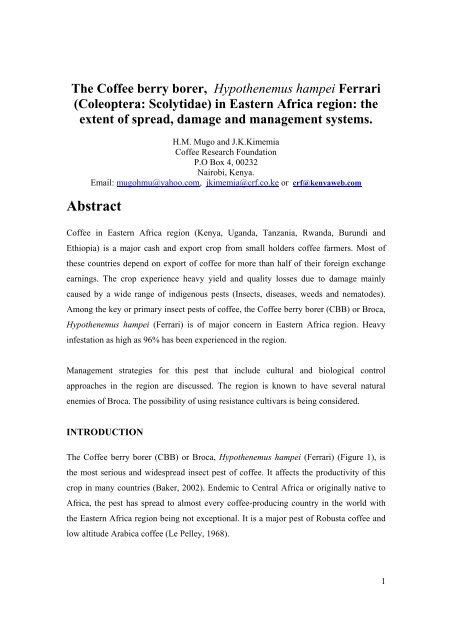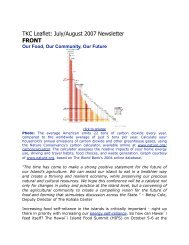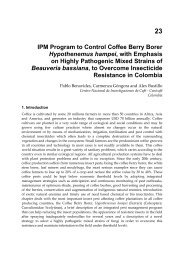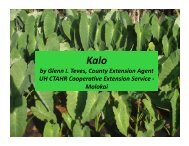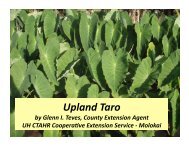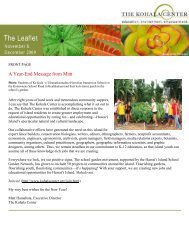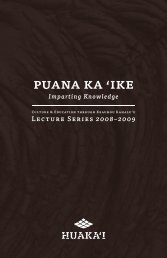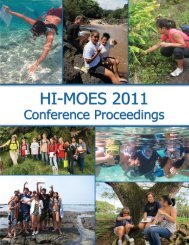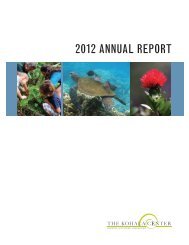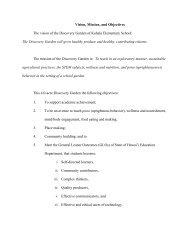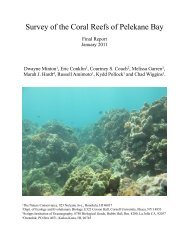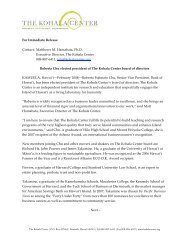The Coffee berry borer, Hypothenemus hampei Ferrari
The Coffee berry borer, Hypothenemus hampei Ferrari
The Coffee berry borer, Hypothenemus hampei Ferrari
You also want an ePaper? Increase the reach of your titles
YUMPU automatically turns print PDFs into web optimized ePapers that Google loves.
<strong>The</strong> <strong>Coffee</strong> <strong>berry</strong> <strong>borer</strong>, <strong>Hypothenemus</strong> <strong>hampei</strong> <strong>Ferrari</strong><br />
(Coleoptera: Scolytidae) in Eastern Africa region: the<br />
extent of spread, damage and management systems.<br />
H.M. Mugo and J.K.Kimemia<br />
<strong>Coffee</strong> Research Foundation<br />
P.O Box 4, 00232<br />
Nairobi, Kenya.<br />
Email: mugohmu@yahoo.com, jkimemia@crf.co.ke or crf@kenyaweb.com<br />
Abstract<br />
<strong>Coffee</strong> in Eastern Africa region (Kenya, Uganda, Tanzania, Rwanda, Burundi and<br />
Ethiopia) is a major cash and export crop from small holders coffee farmers. Most of<br />
these countries depend on export of coffee for more than half of their foreign exchange<br />
earnings. <strong>The</strong> crop experience heavy yield and quality losses due to damage mainly<br />
caused by a wide range of indigenous pests (Insects, diseases, weeds and nematodes).<br />
Among the key or primary insect pests of coffee, the <strong>Coffee</strong> <strong>berry</strong> <strong>borer</strong> (CBB) or Broca,<br />
<strong>Hypothenemus</strong> <strong>hampei</strong> (<strong>Ferrari</strong>) is of major concern in Eastern Africa region. Heavy<br />
infestation as high as 96% has been experienced in the region.<br />
Management strategies for this pest that include cultural and biological control<br />
approaches in the region are discussed. <strong>The</strong> region is known to have several natural<br />
enemies of Broca. <strong>The</strong> possibility of using resistance cultivars is being considered.<br />
INTRODUCTION<br />
<strong>The</strong> <strong>Coffee</strong> <strong>berry</strong> <strong>borer</strong> (CBB) or Broca, <strong>Hypothenemus</strong> <strong>hampei</strong> (<strong>Ferrari</strong>) (Figure 1), is<br />
the most serious and widespread insect pest of coffee. It affects the productivity of this<br />
crop in many countries (Baker, 2002). Endemic to Central Africa or originally native to<br />
Africa, the pest has spread to almost every coffee-producing country in the world with<br />
the Eastern Africa region being not exceptional. It is a major pest of Robusta coffee and<br />
low altitude Arabica coffee (Le Pelley, 1968).<br />
1
Figure 1: Adult <strong>Coffee</strong> <strong>berry</strong> <strong>borer</strong>.<br />
<strong>The</strong> CBB is a small beetle measuring 2mm in length. It attacks the immature and mature<br />
berries. <strong>The</strong> female beetles (CBB) lay 30-50 eggs inside a coffee cherry, which hatch and<br />
develop inside. Both the adult female and larvae damage the coffee berries of all<br />
developmental stages causing defects or the cherry drops off the tree leading to a crop<br />
loss, both in yield and quality (Le Pelley, 1968; Baker, 2002). <strong>The</strong> economic impact due<br />
the CBB infestation is substantial, in terms of loss as yield and quality.<br />
In Africa, yield losses as high as 96% have resulted from <strong>Coffee</strong> <strong>berry</strong> <strong>borer</strong> attack on<br />
coffee (Waterhouse and Norris, 1989). So as to manage these pests, particularly the<br />
coffee insect pests, researchers in the past have tried to identify and develop effective,<br />
economic acceptable and sustainable pest control strategies (Masaba, 1995).<br />
2
EXTENT OF CBB SPREAD<br />
In Kenya the first incidence of CBB was reported in 1928 (Wilkinson, 1929) with low<br />
infestation of 0.7- 7.8%. However, the pest has become major and by 1987 infestation<br />
levels and crop loss was as high as 80% at the coffee peak season (Murphy et al., 1987).<br />
Mugo (2008) survey on CBB spread in Kenya indicated that the pest is still a problem<br />
with all the coffee growing areas surveyed indicating the presence of CBB. Infestation<br />
levels ranging between 0.6- 25 % was recorded. However, the percentage CBB<br />
infestation decreased with increase in management levels. <strong>The</strong> % CBB mortality<br />
experienced from natural enemies attack increased with increase in coffee management<br />
levels.<br />
DAMAGE CAUSED BY CBB<br />
<strong>The</strong> economic damage associated with H. <strong>hampei</strong> is premature fall of berries, beans of<br />
low commercial value, downgraded quality and flavour of the coffee. Its (CBB)<br />
infestation rate varies with altitude. <strong>Coffee</strong> grown in low altitudes is severely affected<br />
than at higher elevation (Murphy and Moore, 1990).<br />
<strong>The</strong> CBB attacks the immature and mature berries where both the adult and larval stages<br />
cause crop loss ranging from 50-100% with reduction in quality of the remaining yield<br />
(Le Pelley, 1968; Waterhouse and Norris, 1989). Crop loss of up to 96% has been<br />
reported to occur in some Eastern African countries (Magina, 2005).<br />
CURRENT AND FUTURE MANAGEMENT STRATEGIES<br />
In order to minimize coffee losses resulting from the CBB infestation, several control<br />
strategies that include cultural, biological and use of broad spectrum chemical pesticides<br />
have been recommended (Mugo, 1994). Some studies had previously considered<br />
inclusion of plant resistance in management of CBB among the cultural and chemical<br />
control approaches but no coffee cultivars resistance to CBB have yet been developed.<br />
3
Cultural control<br />
Cultural control strategies are usually developed to suit specific pests. <strong>The</strong> <strong>Coffee</strong> <strong>berry</strong><br />
<strong>borer</strong> easily survives from one cropping season to the next while inside the coffee berries<br />
that have either dropped on the ground or dried on the trees. <strong>The</strong> most effective cultural<br />
approach in control of this pest is to pick up and completely destroy the berries that are<br />
the potential reservoirs for CBB, at the end of the cropping season through deep burying<br />
or burning. However, this control method is regarded as tedious and rather very labour<br />
intensive especially picking berries off the ground (Le Pelley, 1968; Baker, 1999).<br />
<strong>The</strong>refore it’s advocated that during coffee picking, <strong>berry</strong> dropping to the ground should<br />
be kept to a minimum. Proper drying of coffee beans also helps in reducing the CBB<br />
infestation (Le Pelley, 1968; Baker, 1999; Dufour, 2001).<br />
Chemical control<br />
Chemical control has limited effectiveness because of the biology and feeding behaviour<br />
of this pest. Nearly the entire life cycle of CBB takes place inside the coffee cherry. For<br />
that reason, insecticides applied to control the CBB can be rarely effective against it. For<br />
any insecticides to be effective either wholly or partially, it must be applied before the<br />
CBB adults get into the hardened coffee bean (Mugo, 2006). This to be achieved, the<br />
insecticide requires to be sprayed four to five months after the crop has flowered since<br />
this is the period when the coffee beans hardened and suitable for CBB attack (Mugo,<br />
2006).<br />
Several insecticides have been evaluated and recommended for management of major<br />
insect pests of coffee (Le Pelley, 1968; Wanjala, 1976; Anon, 1997), with some reported<br />
to reduce populations of biological control agents (Wanjala, 1976). Endosulfan, an<br />
organo-chlorine, is mostly used in coffee to manage <strong>Coffee</strong> <strong>berry</strong> <strong>borer</strong> in many parts of<br />
the world. Its frequent use has led to the development of some resistance against it as<br />
reported in New Calendonia (Pacific Ocean) ((Brun et al., 1989; Davis et al., 2001).<br />
4
<strong>The</strong> CBB has an interesting life history that facilitates faster development of resistance<br />
enables it to readily develop pesticide resistance. Most CBB are females in a ratio of<br />
13:1(Brun et al., 1995). Since the males are flightless, they mate with their sisters<br />
because they never leave the cherry in which they are born. This results in genetic<br />
inbreeding. When the mutation for endosulfan resistance occurs, this rapidly spread<br />
through a population because of this inbreeding (Brun et al., 1995). This development of<br />
resistance to endosulfan if it becomes widespread may prove devastating to the<br />
management of CBB.<br />
Organic pesticides extracted from plants/ botanicals such as Neem and pyrethrums, are<br />
usually used in organic farming (Bionature products, 2003). Extracts from Neem and<br />
Tephrosia are used in Tanzania to control the CBB with encouraging results (Magina,<br />
2005). Trapping of CBB for instance by use of “Brocap” usually reduces the CBB<br />
infestation (Dufour, 2001).<br />
Biological control<br />
Biological control through use of natural enemies (parasitoids, fungal pathogens and<br />
parasitic nematodes) enhanced with effective cultural controls and selective insecticide<br />
application helps to keep this pest in check. <strong>The</strong>se includes parasitoids such as Prorops<br />
nasuta Watson, Heterospilus coffeicola Schmied, Cephalonomia stephanoderis Betrem,<br />
Phymastichus coffea; fungal pathogens, the Beauveria bassiana and parasitic nematodes.<br />
A number of these biocontrol agents are indigenous to Eastern Africa region with<br />
reported parasitism levels ranging from 18 to 59% (Le Pelley, 1968). In Kenya for<br />
instance, three parasitic wasps; Prorops nasuta, Phymastichus coffea and Heterospilus<br />
coffeicola (Murphy et al., 1986, 1987; Infante et al,. 1992) have been recorded. <strong>The</strong>se<br />
parasitoids have been exported to countries like Colombia, Guatemala,Honduras,<br />
Jamaica, El Salvador, Ecuador, India, Brazil and Mexico for the control of CBB (Murphy<br />
and Rangi, 1991; Baker et al., 2002). Other natural enemies such as Beuveria bassiana<br />
have also been exported to other countries as part of classical biocontrol where promising<br />
results in parasitism levels have been achieved (Baker et al., 2002). <strong>The</strong> P. coffea unlike<br />
the other parasitoids obtained from East Africa, it parasitizes the adults female CBB<br />
5
efore it enter the coffee bean and moves from <strong>berry</strong> to <strong>berry</strong> (Baker et al., 2002). Thus<br />
P. coffea is considered to be a potentially useful biological control tool in management<br />
of CBB<br />
CONCLUSION AND RECOMMENDATIONS<br />
<strong>The</strong> pest control measures rely heavily on use of synthetic pesticides. Costs of inputs<br />
particularly pesticides, have become unaffordable by most farmers in Africa, and the<br />
increasing concern about pesticides residue risks have evidently led to the need of<br />
developing alternative pest management strategies.<br />
To effectively manage <strong>Coffee</strong> <strong>berry</strong> <strong>borer</strong>, combination of various pest management<br />
strategies which are economically viable, sustainable and environmentally friendly in<br />
Eastern Africa region are advocated. <strong>The</strong>refore in view of the above, the inclusion of<br />
biocontrol, botanicals, cultural and selective insecticides are suitable strategies for<br />
managing the CBB.<br />
New approaches to the control of this pest include development of coffee resistant<br />
cultivars and the possibility of using compound inorganic and organic fertilizers that can<br />
deter or reduce the infestation levels of coffee beans. Work is ongoing at <strong>Coffee</strong> Research<br />
Foundation, Kenya to see how manipulation at nutrition levels could reduce the CBB<br />
incidence.<br />
For better management of the CBB it is will be prudent to get concerted global approach<br />
share strategies / technologies and also natural enemies. <strong>The</strong> ICO could play a crucial<br />
role by bringing affected countries, research organization and development partners<br />
together to develop and execute strategies for the control of CBB.<br />
Acknowledgements<br />
I wish to acknowledge <strong>Coffee</strong> Research Foundation for the financial support. <strong>The</strong> paper<br />
is compiled and published with the permission of the Director of Research, CRF, Ruiru,<br />
Kenya.<br />
6
References<br />
Anonymous, (1997). Recommended Technologies in coffee production. <strong>Coffee</strong> Research<br />
Institute – Lyamungu 12pp.<br />
Baker, P.S. (1999).<strong>The</strong> <strong>Coffee</strong> <strong>berry</strong> <strong>borer</strong> in Columbia. Final report of the DFID-<br />
Cencafe- CABI Bioscience IPM for coffee project (CNTR 93/1536A)<br />
Baker, P. S. (2002). Integrated management of <strong>Coffee</strong> <strong>berry</strong> <strong>borer</strong>. Common Fund for<br />
Commodities (CFC), United States Department of Agriculture (USDA)<br />
and counterpart contributions from national programmes (ICO,<br />
CENICAFE, PROMECAFE,ANECAFE, <strong>Coffee</strong> Board of India and<br />
USDA)<br />
Baker, P. S., Jackson, J.A.F and Murphy, S.T. (2002). Natural enemies, natural allieshow<br />
scientists and coffee farmers forged new partnerships in the war<br />
against pests and low prices, CABI commodities, www.cabicommodities.org<br />
Bardner, R. (1978). Integrated control of coffee pests. <strong>Coffee</strong> Research Station, Ruiru,<br />
Kenya. 43: 502.<br />
Bionature products, (2003). Bionature P-seriesproducts (Organic slow –release pellets).<br />
File://A:\Bio%NATURE%Products20Page.htm<br />
Brun, L. O., J. Stuart, V. Gaudichon, K. Aronstein, and R. H. Ffrench-Constant (1995).<br />
Functional haplodiploidy: a mechanism for the spread of insecticide<br />
resistance in an important international insect pest. PNAS 92:9861-9865.<br />
Brun, L.O., Marcillaud, C., Gaudichon, V. and Suckling, D.M.Jrl (1989). Endosulfan<br />
resistance in <strong>Hypothenemus</strong> <strong>hampei</strong> (Coleoptera: Scolytidae) in New<br />
Caledonia. Econ. Entomol. 82:1311-1316.<br />
Davis,M., Dinhan, B and Williamson, S. (2001). Growing coffee with IPM. A brief for<br />
the IPM in Developing Countries Proect funded by the European<br />
Commission Environment in Developing countries. Pest management<br />
notes No 9.<br />
7
Le Pelley,R.H. (1968). Pests of coffee. Longmans Green and Con. Ltd, London, pp.114-<br />
120.<br />
Magina. F. L. (2005). A review of coffee pest management.<br />
www.aaec.vt.edu/ipmcrspuganda<br />
Masaba, D.M.(1995). Potential for Integrated pest management for coffee smallholders in<br />
Kenya, in: Integrating biological control and host plant resistance.<br />
Proceedings of a CTA/IAR/IIBC seminar. Addis Ababa, Ethiopia. Pp 88-<br />
98.<br />
Mugo.H.M. (2006). Effective application of chemical strategy against <strong>Coffee</strong> <strong>berry</strong><br />
<strong>borer</strong>, <strong>Hypothenemus</strong> <strong>hampei</strong>, infestation in Kenya. Paper presented<br />
during International conference on coffee science, Montepellier, France.<br />
11 th – 15 th September 2006.<br />
Mugo.H.M. (2008). <strong>The</strong> <strong>Coffee</strong> <strong>berry</strong> <strong>borer</strong> (<strong>Hypothenemus</strong> <strong>hampei</strong>) distrbution and the<br />
effect of coffee management practices in kenya .Paper presented during<br />
22 nd International conference on coffee science, Campinas, Brazil.<br />
14 th – 19 th September 2008.<br />
Murphy S. T., Donnel D. J., Mang’ayo F.L., Cross A and Evans H.G. (1986): First<br />
Report of the <strong>Coffee</strong> Berry Borer Project. Unpublished Report CABI<br />
Institute of Biological control. 23pp<br />
Murphy S. T., Donnel D. J., Mang’ayo F.L., Cross A and Evans H.G. (1989): Second<br />
Report of the <strong>Coffee</strong> Berry Borer Project. Unpublished Report CABI<br />
Institute of Biological control. 23pp<br />
Murphy,S.T. and Moore,D. (1990). Biological control of <strong>Coffee</strong> <strong>berry</strong> <strong>borer</strong>,<br />
<strong>Hypothenemus</strong> <strong>hampei</strong> (<strong>Ferrari</strong>) (Coleoptera: Scolytidae): Previous<br />
programmes and possibilities for the future. Biological News and<br />
Information 11, 107-117.<br />
Murphy S. T and Rangi, D.K. (1991): <strong>The</strong> use of African wasp, Prorops nasuta for the<br />
control of the coffee <strong>berry</strong> <strong>borer</strong>, <strong>Hypothenemus</strong> <strong>hampei</strong> in Mexico and<br />
Ecuador: <strong>The</strong> introduction programme. Insect Sc.Appln. (ICIPE). 12 (1-2-<br />
3). 27-34.<br />
Waterhouse,D.F. and Norries, K.R. (1989). Biological control: Pacific Prospects<br />
8
Supplement 1. <strong>Hypothenemus</strong> <strong>hampei</strong> (<strong>Ferrari</strong>), Australian Centre for<br />
International Agricultural Research, Canberra, Australia, pp 57-75.<br />
Wilkinson, H. (1929). Rep Entomologist, Rep.Dept.Agric.Kenya, 1928. 172-186 Nairobi<br />
Infante, F., J. F. Barrera, S. T. Murphy, J. Gómez, and A. Castillo. (1992). Cría y<br />
cuarentena de Phymastichus coffea LaSalle (Hymenoptera: Eulophidae)<br />
unparasitoide de la broca del café introducido a Mexico. XV Simposio<br />
Latinoamericano de Cafeticultura, Xalapa, Veracruz, 80 pp.<br />
9


